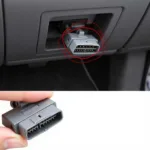The OBD2 code P1131 is a common issue that many car owners face. It indicates a problem with the O2 sensor, specifically a lack of switching for the Heated Oxygen Sensor (HO2S) 1, Bank 1, Sensor 1. This code can be frustrating to deal with, but understanding its meaning and causes can help you get to the root of the problem and fix it effectively.
What Does OBD2 Code P1131 Mean?
In simple terms, the P1131 code means that the engine control unit (ECU) has detected a problem with the oxygen sensor’s ability to measure the air-fuel ratio in the exhaust. This sensor plays a crucial role in ensuring optimal engine performance and fuel efficiency. When it malfunctions, it can lead to a range of issues, including:
- Reduced fuel economy: An incorrect air-fuel mixture can cause the engine to burn more fuel than necessary.
- Increased emissions: A rich fuel mixture can lead to higher emissions of harmful pollutants.
- Poor engine performance: The engine may experience rough idling, hesitation, or loss of power.
- Illuminated check engine light: The P1131 code will trigger the check engine light on your dashboard.
What Causes OBD2 Code P1131?
The P1131 code can be triggered by a variety of factors, including:
- Faulty O2 sensor: This is the most common cause of the P1131 code. Over time, the sensor can become contaminated or wear out, leading to inaccurate readings.
- Vacuum leaks: A leak in the intake manifold or other vacuum hoses can disrupt the air-fuel ratio, causing the O2 sensor to report an error.
- Exhaust leaks: Leaks in the exhaust system, such as a cracked exhaust manifold or a leaking exhaust gasket, can also affect the O2 sensor readings.
- Wiring issues: Damaged, corroded, or loose wiring connections to the O2 sensor can interrupt the signal transmission.
- Faulty fuel injectors: Malfunctioning fuel injectors can cause an overly rich or lean air-fuel mixture, impacting the O2 sensor’s ability to function correctly.
- Faulty ECU: While less common, a malfunctioning ECU can also trigger the P1131 code.
How to Diagnose and Fix OBD2 Code P1131
Diagnosing and fixing the P1131 code requires a systematic approach:
- Read the Code: Use an OBD2 scanner to retrieve the specific trouble code stored in your vehicle’s ECU.
- Inspect the O2 Sensor: Visually inspect the O2 sensor for any signs of damage, contamination, or loose connections. Pay attention to the wiring harness as well.
- Check for Vacuum Leaks: Inspect the intake manifold, vacuum hoses, and related components for any leaks.
- Inspect the Exhaust System: Look for any holes, cracks, or loose connections in the exhaust manifold, pipes, and muffler.
- Test the O2 Sensor: If the visual inspection doesn’t reveal any obvious issues, use a multimeter to test the O2 sensor’s voltage output.
- Check Fuel Pressure: Ensure the fuel pressure is within the manufacturer’s specifications.
- Inspect Fuel Injectors: Check the fuel injectors for clogging, leaks, or other signs of malfunction.
- Consult a Mechanic: If you’re unable to pinpoint the exact cause, or if you’re not comfortable performing the repairs yourself, it’s best to consult a qualified mechanic.
Replacing the O2 Sensor
In many cases, replacing the faulty O2 sensor is the most effective solution. Here’s a general guide:
- Locate the O2 Sensor: Consult your vehicle’s repair manual to determine the exact location of the Bank 1, Sensor 1 O2 sensor.
- Disconnect the Battery: Disconnect the negative battery cable to prevent electrical shorts during the replacement process.
- Unplug the Sensor: Carefully unplug the electrical connector from the O2 sensor.
- Remove the Old Sensor: Using an O2 sensor socket, loosen and remove the old sensor from the exhaust pipe.
- Install the New Sensor: Apply anti-seize compound to the threads of the new sensor and carefully thread it into the exhaust pipe. Tighten it to the manufacturer’s specifications.
- Reconnect the Wiring: Plug the electrical connector back into the new O2 sensor.
- Reconnect the Battery: Reconnect the negative battery cable.
- Clear the Code: Use your OBD2 scanner to clear the P1131 code and any other stored codes.
- Test Drive: Take your vehicle for a test drive to ensure the check engine light stays off and the engine is running smoothly.
OBD2 Code P1131: Frequently Asked Questions
Q: Can I drive my car with the P1131 code?
A: While you might be able to drive for a short distance, it’s not recommended. Driving with a faulty O2 sensor can lead to further engine damage and reduced fuel efficiency.
Q: How much does it cost to replace an O2 sensor?
A: The cost of replacing an O2 sensor varies depending on the make and model of your vehicle and labor costs in your area. Typically, you can expect to pay between $200 and $400 for parts and labor.
Q: How often should I replace my O2 sensors?
A: O2 sensors typically last between 60,000 and 100,000 miles. However, it’s a good idea to consult your vehicle’s maintenance schedule for specific recommendations.
Need More Help with OBD2 Codes?
For further assistance with OBD2 codes like P1131 or any other car diagnostic needs, reach out to our team. Contact us via WhatsApp: +1(641)206-8880 or Email: [email protected]. Our 24/7 customer support team is ready to assist you. Explore our website for a comprehensive guide on various OBD2 codes and their solutions. You can find more detailed information on the P1131 code, including specific instructions for different car models, by visiting our dedicated page: obd2 code p1131 o2 sensor bank 1. We are committed to being your trusted resource for all things OBD2.
